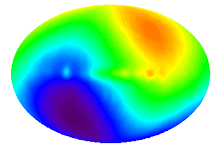From prokaryotes to
eukaryotes
The appearance of eukaryotic cells ~2 billion years ago
has been linked to the introduction of oxygen in the atmosphere and therefore
aerobic metabolism. The increased presence of oxygen produces a more efficient
energy source in the form of aerobic metabolism, producing 16–18 times more
adenosine triphosphate (ATP) per hexose sugar than anaerobic metabolism. Since
aerobic metabolism generates more energy, approximately 1000
more reactions can occur than under anaerobic metabolism.
This allowed the generation of new metabolites, for
example, steroids, alkaloids and isoflavonoids
Steroids and polyunsaturated fatty acids are important
elements of membranes; thus, they must have been involved in promoting
organelle formation and cell compartmentalisation.
As some of the metabolites produced from respiration are
involved in processes that target nuclear receptors, it has been hypothesized
that higher ambient oxygen promoted these nuclear signalling systems within
cells. Nuclear factors have conserved volumes and are highly hydrophobic, since
they must pass through cell membranes. Experiments comparing the volume and
hydrophobicity of both aerobic and anaerobic metabolites to those known for
nuclear ligands indicate that aerobic metabolites are more hydrophobic and more
closely match the required volumes of appropriate molecules for nuclear factors
compared to the anaerobic molecules.
Since these appear important in superior eukaryotes, it
has been hypothesized that such events influenced by increased oxygen levels
have influenced biological evolution.
approximately 68% of transmembrane proteins in humans are
high-oxygen content, whereas in most bacteria, such as E. coli,
only 36% are oxygen rich. The size of the extracellular domains of
transmembrane proteins increased as ambient oxygen concentration increased.
The size of the extracellular domains of transmembrane
proteins increased as ambient oxygen concentration increased.
Larger and higher oxygen-containing proteins are more
energy demanding than those lacking oxygen in their side chains. However, the
primary hypothesis suggests that the presence of large and oxygen-rich amino
acids as side chains would have resulted in weak protein structures during
anoxic eras
Eukaryotes assign more communication roles to proteins
than prokaryotes, allowing for more complex and variable signalling pathways.
In order to achieve this, various changes in protein structure and function had
to occur during evolution. The secondary structures of transmembrane proteins
are more hydrophobic, and oxygen as well as nitrogen is important during the
formation of hydrophilic structures. Acquisti et al. studied the oxygen content
and the topology of transmembrane proteins of different organisms. The ratio of
receptors to channels was higher, with a greater amount of oxygen-rich
proteins, in more highly developed and ‘recent’ organisms. For example,
approximately 68% of transmembrane proteins in humans are high-oxygen content,
whereas in most bacteria, such as E. coli, only 36% are oxygen rich. The
size of the extracellular domains of transmembrane proteins increased as
ambient oxygen concentration increased. Larger and higher oxygen-containing
proteins are more energy demanding than those lacking oxygen in their side
chains. However, the primary hypothesis suggests that the presence of large and
oxygen-rich amino acids as side chains would have resulted in weak protein
structures during anoxic eras. Eukaryotes have an abundance of oxygen in the
plasma membrane, as oxygen is utilized in the mitochondria. This
compartmentalisation may have evolved as a mechanism to protect the
transmembrane proteins, which are rich in oxygen. Through the development of
complex compartmentalisation of cells, multiple processes including signalling
and oxygen levels could also be controlled in different parts of the cell. In
addition, there has been the emergence of multiple cell types within the same
‘greater’ organism, with over 200 different
cell types in the adult human body. Multicellular organisms
may have required both the accumulation of oxygen-rich amino acids in their
transmembrane proteins and the allocation of respiration to specific
intracellular compartments, that is, mitochondria.

沒有留言:
張貼留言